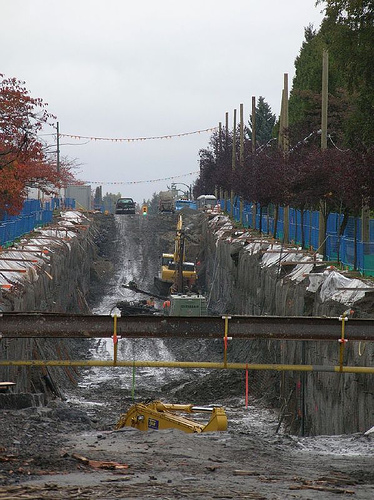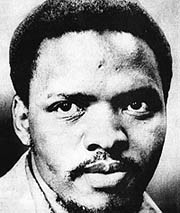
YVR Taser death
October 15, 2007 in Opinion
Two men died yesterday after separate Taser incidents. Donald Clark died in an Asheville, North Carolina hospital after being Tasered Saturday, while closer to home, the death of an unidentified man at the Vancouver International Airport (YVR) has been grabbing headlines. These latest deaths bring the number of people who have died in North America after being shocked with the Taser’s 50,000 volt output to at least 284. (By the way, a number of domestic animals, including a loose cow in Spokane, Washington, have also died after being shocked with the Taser, raising further skepticism about the police and manufacturer’s claims that the electrical output of these weapons is harmless.)
Although 16 people have died in Canada since April of 2003, there are still no independent safety testing protocols or standards in this country. Unlike hair dryers, toasters, electric fences or cattle prods, Tasers are not subject to any testing before being sold.
How were Tasers introduced into Canada without any public debate? The answer lies in the aggressive marketing tactics and dubious claims of the manufacturer, Scottsdale, Arizona public company Taser International Inc. Taser International enlisted police officers to help promote the “Thomas A. Swift Electric Rifle”, giving some of them stock options and cash payments for their efforts. Victoria, BC police officer Darren Laur, who wrote some early Taser endorsements, is one such police officer. Another police source has advised me that many police officers benefited from promoting the weapon, raising at least the spectre of a possible conflict of interest.
No wonder then, that the police are such advocates of this “less than lethal” device that inflicts excruciating pain and disables its victims. They will never say a negative word about the weapon, even as the death toll inevitably rises. That’s why independent and rigorous safety testing is needed…now.
….
The Canadian deaths:
1. April 19, 2003: Terrance Hanna, 51, Burnaby, BC (RCMP)
2. July 22, 2003: Clay Willey, 33, Prince George, BC (RCMP)
3. Sept. 28, 2003: Clark Whitehouse, 34, Whitehorse, Yukon (RCMP)
4. March 23, 2004: Perry Ronald, 28, Edmonton, Alta.
5. May 1, 2004: Roman Andreichikov, 25, Vancouver, BC
6. May 13, 2004: Peter Lamonday, 38, London, Ont.
7. June 23, 2004: Robert Bagnell, 44, Vancouver, BC
8. July 17, 2004: Jerry Knight, 29, Mississauga, Ont.
9. August 8, 2004: Samuel Truscott, 43, Kingston, Ont.
10. May 5, 2005: Kevin Geldart, 34, Moncton, NB (RCMP)
11. June 30, 2005: Gurmeet Sandhu, 41, Surrey, BC (RCMP)
12. July 1, 2005: James Foldi, 39, Beamsville, Ont.
13. July 15, 2005: Paul Saulnier, 42, Digby, Nova Scotia (RCMP)
14. December 24, 2005: Alesandro Fiacco, 33, Edmonton, Alta.
15. August 30, 2006: Jason Doan, 28, Red Deer, Alta. (RCMP)
16. October 14, 2007: Unidentified male, Richmond, BC (RCMP)
posted by Cameron Ward
Another BC Taser-related death
October 14, 2007 in Opinion

Update: The dead man has been identified as Robert Dziekanski, 40, a new immigrant from Poland. He had no criminal record and had no drugs or alcohol in his system. A passerby took a video of the incident and gave it to RCMP investigators who told him they would return it the next day. The investigators have now refused to return the videotape.
Two more people have died after being Tasered-Donald Clark of Asheville, N.C. on October 14th and Quillem Registre of Montreal, Quebec on October 17th-bringing the total number of fatalities to 285.
……
An unidentified man died after he was Tasered by RCMP at the Vancouver International Airport early this morning. He is at least the 283rd person to die in North America after being shocked with the Taser’s 50,000 volt electrical output. Sixteen of those deaths have occurred in Canada since 2003, and the latest is the sixth BC fatality. The RCMP has been involved in eight of the Canadian deaths.
The police will investigate this incident themselves and clear the Taser of any responsibility, perhaps blaming the unfortunate man’s death on “excited delirium”, which is not a recognised medical condition.
The Taser was quietly introduced into Canada in 2000, without any public debate or prior independent safety testing. Although electric fences and cattle prods must undergo rigorous tests before being sold, the Taser is subject to no such control.
The list of Canadian fatalities:
1. April 19, 2003: Terrance Hanna, 51, Burnaby, BC (RCMP)
2. July 22, 2003: Clay Willey, 33, Prince George, BC (RCMP)
3. Sept. 28, 2003: Clark Whitehouse, 34, Whitehorse, Yukon (RCMP)
4. March 23, 2004: Perry Ronald, 28, Edmonton, Alta.
5. May 1, 2004: Roman Andreichikov, 25, Vancouver, BC
6. May 13, 2004: Peter Lamonday, 38, London, Ont.
7. June 23, 2004: Robert Bagnell, 44, Vancouver, BC
8. July 17, 2004: Jerry Knight, 29, Mississauga, Ont.
9. August 8, 2004: Samuel Truscott, 43, Kingston, Ont.
10. May 5, 2005: Kevin Geldart, 34, Moncton, NB (RCMP)
11. June 30, 2005: Gurmeet Sandhu, 41, Surrey, BC (RCMP)
12. July 1, 2005: James Foldi, 39, Beamsville, Ont.
13. July 15, 2005: Paul Saulnier, 42, Digby, Nova Scotia (RCMP)
14. December 24, 2005: Alesandro Fiacco, 33, Edmonton, Alta.
15. August 30, 2006: Jason Doan, 28, Red Deer, Alta. (RCMP)
16. October 14, 2007: Robert Dziekanski, 40, Richmond, BC (RCMP)
17. October 17, 2007: Quillem Registre, 39, Montreal, Quebec
posted by Cameron Ward
System needs reform, in-custody death forum hears
September 25, 2007 in News
UPDATE: On Thursday, October 25, 2007, Mr. Ward will be speaking at “Aboriginal Deaths in Custody”, a public forum to be held at the Aboriginal Friendship Centre from 9:30 to 4:00. Other speakers include author Warren Goulding, pathologist Dr. John Butt, Kyle Tait’s mother Noel Tait and journalist Leonard Cler-Cunningham.
The forum precedes the Frank Paul Inquiry, which is scheduled to commence November 13, 2007. The Commissioner has issued a ruling on standing, that can be linked here: upload
…….
At a BCCLA forum on police in-custody deaths in Vancouver yesterday, speaker after speaker recounted their experiences with a justice sytem that is hopelessly skewed in favour of the police, at least as far as police-involved homicides are concerned. Linda Bush, Sylvia Fee and Delores Young, each of whom lhad a loved one shot to death by police, expressed frustration at the secretive and biased investigative process that followed the separate incidents and inevitably cleared the police of any responsibility.
For my part, I said that the time for a measured, polite response to the problem is over: real reform is needed. I called for an end to the system whereby police investigate themselves in these cases, and for meaningful changes to the BC Coroners’ Service.
When police investigate their brethren, their investigations are so flawed as to amount to corrupt whitewashes, especially here in Vancouver. Every VPD investigation of a death at the hands of a VPD member follows the same script…all the officers involved leave the scene, consult their union rep and joint lawyer and, weeks later, after other investigative results are in, their lawyer delivers typed statements on their behalf. The members involved, whether witnesses or perpetrators, are never interviewed right away and often are not interviewed at all. The opportunities for collision and tainting are rife. Police investigators would never conduct a criminal investigation of civilians this way. There is no wonder that no police officer in BC, in my memory, has ever been prosecuted for a death resulting from the intentional application of force.
Although it is mandatory for a coroner’s inquest to be held in the case of every death in custody, the BC Coroner’s Service is either incompetent or biased, or both, in the way it handles these cases. Though it has the power to conduct independent investigations, it merely collects the police investigative results. Why, I asked, do we have a former senior RCMP officer heading up an agency that has the responsibility for investigating deaths caused by actions of the police? At the very least, there is a perception of bias.
Ontario Ombudsman Andre Marin, former head of the Ontario SIU (Special Investigations Unit) said that it is only a matter of time before BC leaves the “dark ages” and moves to a civilian investigative system. “Police should never, under any circumstances, be investigating themselves where there’s a serious injury or death-full stop”, he said.
BC Solicitor General John Les, who was invited to the forum but declined to attend, reportedly called Marin’s comments “juvenile” and “inappropriate”.
By the way, on January 15, 2004, a five person coroner’s jury conducting an inquest into the death of a man who was shot six times by two VPD officers called on the BC Solicitor General to “Implement a special investigations unit similar to the SIU in Ontario, independent of the police, to investigate circumstances involving police which result in serious injury, assault or death.”
The Solicitor General has not done anything to implement those recommendations, perhaps because he considers them to be juvenile and inappropriate. Click below to see the jury’s recommendations in the case of Tom Stevenson:
posted by Cameron Ward
Cambie Street businesses keep suffering
September 19, 2007 in Opinion
Canada Line (RAV) construction is well under way in Vancouver, as evidenced by massive open trenches, noise, dust and traffic congestion. Businesses along Cambie Street are bearing the brunt of the disruption with no relief in sight from the governments that have committed billions of tax dollars to the project.

Although provincial Minister of Finance Carole Taylor has sympathized with the businesses’ plight, no meaningful aid has been forthcoming. One objection, that compensation would set a dangerous precedent, does not withstand scrutiny. Governments routinely compensate businesses that lose revenues as a result of public endeavours. For example, the federal government compensated those businesses that lost customers due to the G8 summit in Kananaskis and the more recent summit in Montebello. Whistler Mountain will be compensated handsomely for making its property available for the 2010 Olympic Games. More to the point, the Musqueam Band will be compensated an undisclosed amount for lost fishing opportunities created by the erection of Canada Line abutments in the Fraser River.
Another objection may be the cost of a compensation package. Again, that can’t have any merit. The cost of the Canada Line project has crept from $1.2 billion to $1.5 billion to $1.72 billion to the most recently reported figure of $1.9 billion (2003 dollars), which is in excess of $2.1 billion. Whatever amount is needed to compensate the small businesses that have gone under or are struggling to survive, the amount is modest in comparison to the public funds being spent.
The British Columbia government, a major funding partner in this P3 mega-project, portrays itself as business-friendly. The businesses along Cambie Street, at least those that are still there, have a hard time swallowing that proposition and one of them, Hazel & Co., has launched a legal action for damages based on misrepresentations, nuisance, trespass and injurious affection. More businesses may have no choice but to follow suit…
posted by Cameron Ward
Stephen Biko
September 12, 2007 in Opinion
Today, September 12th, is the 30th anniversary of the death of Stephen Biko.

May he rest in peace, and may his struggle never be forgotten.







 Follow this site using RSS
Follow this site using RSS

